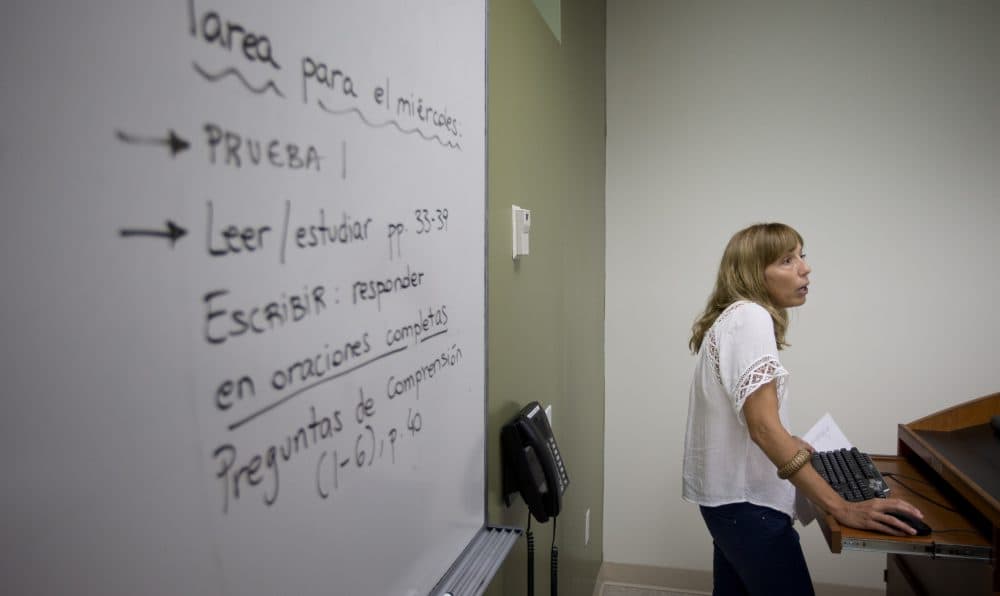Advertisement
Speaking My Language
Why There's A Language Learning Gap In The United States
Resume
According to the U.S. Census Bureau, 60 million Americans speak a language other than English at home. But more than 231 million speak only English at home, and don't know another language well enough to communicate in it.
Marty Abbott, executive director of the American Council on the Teaching of Foreign Languages, says not only is there a language learning gap in the U.S., it's actually getting worse.
"The [enrollment] in schools is dropping," Abbott tells Here & Now's Jeremy Hobson. "At the K-12 level we have approximately 20 percent of students enrolled in language courses, and when you get to postsecondary level, that drops to 8.1 percent."
Interview Highlights
On why it's important to have people who are bilingual
"We need increasingly to be able to interact with the rest of the world, to engage with them, to be able to compete economically and diplomatically. And if you don't have the language skills, you truly do not understand other cultures, and you're not able to fully engage with the rest of the world. We think naively sometimes that business gets done at the business table, but it often gets done away from the business table — it gets done in social interactions, it gets done even in the hallways. And if you don't speak the language, you can't fully engage in those interactions."
"I think Americans have a mindset that, as a country, we're not good at languages ... and that's a false idea."
Marty Abbott
On if French, Spanish, German, Latin and Japanese remain the most commonly taught languages in high schools
"Spanish, French, German and Latin continue to be very commonly taught in the U.S. But we are increasingly adding other languages, like Mandarin Chinese, Arabic, Korean, Portuguese, there's some Italian taught in K-12. Also, we're seeing languages that reflect the communities in which the schools exist.
"Russian was big in the mix in the late '50s/early '60s when Sputnik was launched and we thought we were losing the space race. It's still very actively taught, and really made a comeback after the breakup of the Soviet Union."
On how old is too old to start learning a language
"You're never too old to start learning a language. We have a number of senior citizens interested in learning a language, because we know from the research that it wards off the degeneration of the brain, some of the Alzheimer's diseases. So we have a number of senior citizens eager to learn languages for that reason. But we also know that no matter when you start, you can be a successful language learner. What happens with the younger children is that they still have the ability to be sound like a native speaker in another language. ... It's definitely a matter of time on task, so the earlier you start and the longer you stay with that language, the more proficient you become."
On what's behind enrollment in language programs falling in recent years at U.S. colleges and universities
"I think Americans have a mindset that, as a country, we're not good at languages, that they're tough, they're challenging, that maybe only academically gifted students can do it. And that's a false idea, because we were able to learn our first language. Most of the rest of the world grows up bilingually, with the knowledge of more than one language. It just hasn't been our normal in the United States.
"So that's what we're trying to do, is create a new normal, where it's perfectly feasible for someone to grow up learning two languages. We're trying to raise that awareness among parents and students, that there is a critical link to learning another language and having success in your career and being much more employable if you have another language."
On the No. 1 thing that would help improve language education in the U.S.
"I think it really starts with raising the awareness. We think the rest of the world speaks English, which isn't true: 75 percent of people outside the United States don't speak English, and if they do, it's not at a very high level of proficiency. So we really need to open up to the rest of the world, and the way languages are being taught now, with the communicative approach, really makes it feasible for anyone to learn a language."
This article was originally published on July 16, 2018.
This segment aired on July 16, 2018.